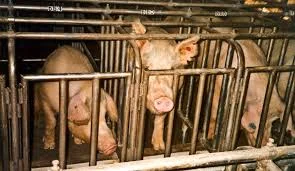What is it about the meat industry? Vegans say meat is murder, what’s clear is that its production often defies morality.
A recently published inquiry by the Equality and Human Rights Commission (http://bit.ly/aKqz2U) has been pretty horrifying: women working in meat and poultry processing factories barred from going to the lavatory because it would slow down the production line. Result: urine and blood (if they’re menstruating) dripping down their legs. Angry managers pelt workers with frozen hamburgers and call them ‘you f***ing’ shit Polish.’
Press reports use terms like “Treated Like Animals.” I guess we take brutal and uncaring animal treatment for granted: cattle in Colorado feedlots up to their knees in their own shit, sick with e.Coli infections and salmonella. US poultry meat has to be washed with chlorine before it can safely be put on sale. I visited a chicken farm in West Virginia 18 months ago: the ammonia from fermenting chicken poop burned your eyes so badly that we could only stand in the shed full of 100,000 birds for a minute before we had to retreat to the fresh air outside. The country girl who assisted the manager commented that she had got used to the smell: her job entailed removing the dead birds every day. The corpses were then burned to generate heat that was helped heat the chicken barn – as recycling efforts go, probably a cut above grinding them up and feeding them to the survivors.
In the 19th Century a report from a Royal Navy vessel that intercepted a slave ship summarised conditions on that most horrendous of transatlantic voyages. “The sick, the dead and they dying were pulled up onto deck, shackled together, and thrown overboard.” The slaves were tethered in cubicles about 2 feet wide and 3 feet high for the entire voyage, which could last 4-12 weeks. The longer the trip the higher the death rate. Slave ships were ‘tight pack’ or ‘loose pack.’ ‘Tight pack’ profitably fitted more slaves into a ship, but the death rate was much higher: 10-20%. Modern pig and chicken factory farms go for ‘tight pack,’ raising the death rate to 5-14%, even with routine antibiotic use. Disease spreads in conditions where faeces cannot be cleared – even slaves above deck were chained in place for the entire voyage – otherwise they would jump overboard to escape the conditions.
I suppose when we consider the cruelty that surrounded the slave trade we shouldn’t be surprised that similar evils infest the meat industry. The trust of an animal is a wonderful thing. As pets they have a therapeutic effect that defies medical explanation. Yet if someone were to take a puppy or a kitten, smother it in its own excrement for a month or so, torture it, starve it and throw it into a furnace while it was still alive they’s be excoriated on the cover of the Daily Mail.
A new dairy ‘farm’ in Lincolnshire is planned to house 8100 dairy cows in darkened stalls, modelled on American dairy production. It is estimated that half of US dairy cows suffer from mastitis and they also suffer leukaemia, milk fever and a bovine form of AIDS. ‘Downers’ – cows that collapse - are turned into ground beef before they can die and become unsuitable for consumption.
It’s not often that Human Rights Watch take up cudgels on behalf of American workers, but they have pointed out that meat industry workers have 3 times the injury rate of other industries, with workers being asphyxiated by fumes and having their legs cut off and their hands crushed.
When you look at the cruelty we inflict on animals is it any wonder that we treat abattoir workers so badly? When you look at the kindness that typifies organic animal rearing, is it any wonder that places like the exemplary biodynamic Laverstoke Farm build their own meat processing facilities, carefully designed to keep the animals calm right up to the final moment, rather than send them off to a slaughterhouse where the people, let alone the animals are treated like…well, slaves.
People somehow manage to get over their concerns about animal welfare when they buy non-organic meat in a shop or restaurant, but how easy is it to be a participant in the human degradation as well?











